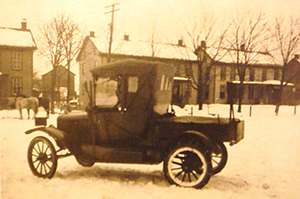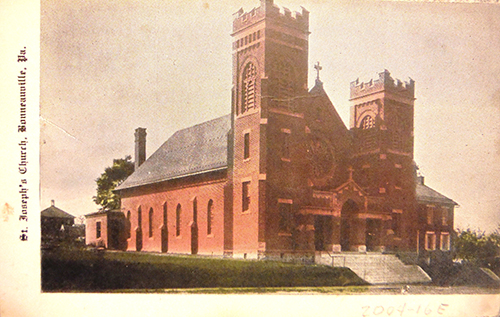The Borough Of Bonneauville
is located in Adams County, Mount Pleasant Township, Pennsylvania.

Although Bonneauville existed by name since 1789 or earlier, it was not incorporated until 1961. It was on May 27, 1789 that Richard McAllister, a store owner in Hanover, PA, penned the word “Bonaghtown” behind the name John McClean, in his store ledger. McAllister’s is the earliest usage of the town’s name that has been found to date.
Right: A century ago. Cigar manufacturer E. L. Golden experimented with a Model T Ford dealership.
The town appears to have had its humble beginnings when a blacksmith shop, a log hotel and a few houses sprang up at the intersection where the roads from New Oxford to Two Taverns and Hunterstown to Littlestown crossed at odd angles (“The Bonneauville Square”.) The original building plots were carved from a Low Dutch Plantation named “Beautiful,” on which the town now lies. Some current Bonneauville Borough borders still follow the same property lines as the 1743, pre-French and Indian War plantation. Though somewhat concealed, the original home for Beautiful Plantation still stands. Until the year 1800 the small settlement of Bonneauville was populated primarily by the Low Dutch who of course, spoke the Dutch language. From the year 1800 on, Pennsylvania Germans occupied the village homes and surrounding farm land. They spoke German until around the time of the Civil War when both the state and the church slowly convinced most individuals to learn and communicate in English. (At first, the parish priest preached the sermon in English every other week to encourage the transition.)

Bonneauville Civil War soldier and accompanying lady.
By the mid-20th Century, the population of the town was about 97% Catholic. Slowly over the past half-century the town has transitioned into a bedroom community of nearly 2000 persons with a broad range of cultural backgrounds.
The Bonneauville Post Office was closed down about 1912. By then the evolution of the automobile allowed economical mail delivery from Gettysburg.

Right: In 1909 the town’s only church was completely rebuilt for its fiftieth anniversary.
Bonneauville was once home to one of the most famous cigar manufactories in the country. Chain, buggy, wagon, casket and furniture manufacturing businesses prospered. Shoe makers, a tanner, a harness maker and a goodly population of skilled craftsmen, carpenters and masons, plasterers, seamstresses, mechanics, farmers and others shared space with general store owners, blacksmith shops and garages. New and used automobile dealers, banks, barbers, beauticians, and many others also plied their trades.
As a result of the mix of languages and cultures; during a time when some folks were still signing their names with an “X”, spellings of the town’s name have varied greatly. Among the various spellings that I have found in old letters, documents, maps and books are: Bonaghtown, Bonaghs Town, Bonneaus Town, Bonagton, Bonaughton, Bonneautown, Bonnichtown, Bonneville, Bonnichtown, Bonningstown, Bonaughtown, Bonoughtown, Bunnichtown, Bonneaus Town, Booneville and Bonneauville. Additionally the town was called Newville for a few years around 1872.